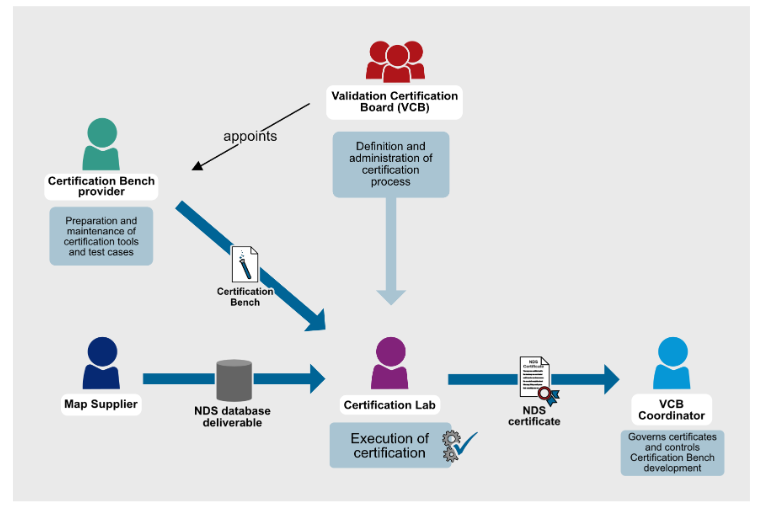The NDS map certification is an essential step in the delivery of NDS databases – and moreover, it is required by the bylaws of the NDS association. As a final and mandatory step of the NDS database publication and release process, it serves the following two key purposes:
The process ensures that NDS-based applications can retrieve and use data from a NDS database in a standardized manner. Certification tests verify that the structure of a NDS database is according to the NDS format specification. In addition to the test cases specified for map certification, there are also test cases that are used for validation. This reduces the testing effort for the individual members.
Leading automotive companies collaborate on the definition of NDS format specification and interfaces. With this, they create a shared pool of intellectual property. The NDS member companies agree by signing the association bylaws and licensing agreement that this intellectual property is owned by all NDS association members and shall only be used within certified NDS data publications. This ensures that all members contribute to the evolution of NDS and that all new features can be used by all members equally.

For the certification and verification, NDS members use the NDS Certification Bench. It is a tool developed, maintained and provided to NDS members by the NDS Association. This work is contracted to the engineering company TechConnect GmbH.
The Certification Bench consists of several modules: Test cases, Validation Suite, Profiler and the NDS version profiles themselves. Certification is run in two steps. Firstly, the Validation Suite executes the test cases and produces the test results as well as the logs needed for generating a certificate. In the next step, the Profiler takes the test results from the Validation Suite and generates the certificate.
NDS members benefit from map database test cases and tool development provided by the NDS Association.
Every member company that published NDS maps can run the full Certification Bench at their premises to identify possible issues related to the structure of the NDS map and if all goes well, to generate the mandatory certificates. Running the Certification Bench helps the NDS member companies to uncover any issues in the map building before publication and to get fixes in place in order to pass the NDS map certification process.
When test cases fail, they can be discussed in the weekly Validation Suite Board (VSB) call. This is a forum in which the technical aspects of Validation Suite execution and its test cases are discussed. TechConnect is a key member of the VSB because of its role as the engineering partner for the Certification Bench. When needed, decisions on how to resolve issues are made in this forum. This can be the improvement of test cases or the possibility of recommending the granting of a test case waiver.

The Validation Certification Board (VCB) is the team that defines and manages the certification process. The VCB also maintains the Certification Process Documentation and records certified NDS databases. The team consists of representatives of the NDS association member companies. This year, nine NDS association members collaborate on the VCB. Every two weeks the members meet virtually to discuss and decide on certification related topics and issues. Additional in-person workshops are held to make decisions on map certification process improvements and tooling.
The NDS Association contracts a VCB Coordinator who leads the activities of the VCB team and who reports directly to the NDS Steering Committee. André Heinrich of IAV GmbH is our current VCB Coordinator since 2017.
Over the last 7 years, more than 1,400 NDS databases with map data covering all world regions have been certified and published. On average, that is 20 certificates per month. Impressive, isn’t it?
Back to news →